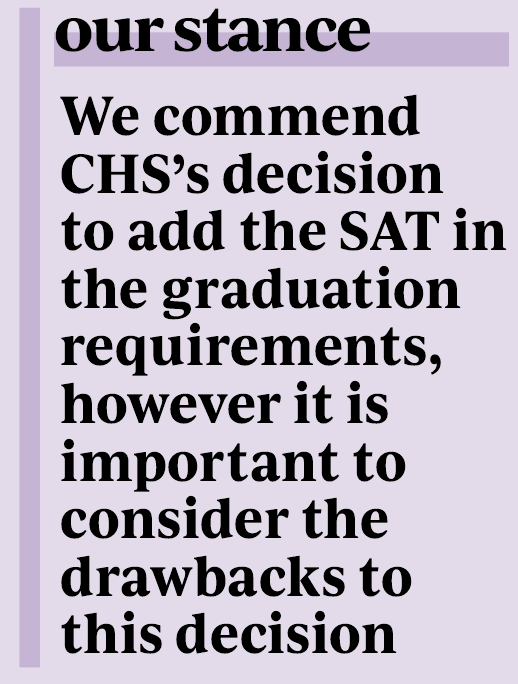Beginning this school year, the Indiana Department of Education changed graduation standardized testing requirements from the ISTEP to the SAT. Additionally, students can now use the SAT to fulfill one of three graduation requirements, the postsecondary-ready competencies requirement. However, while the decision is commendable, it may not be in the best interest of everyone.
First, though, the change is not without merit. Students are now required to take the SAT as their accountability assessment in the spring of their junior year of high school, where previously students would take the ISTEP in their sophomore year. The change gives students more time to develop the skills needed to succeed in tests of this nature. Additionally, students will now be able to take the SAT test for free without having to pay the testing fees. This is good for students of all backgrounds, but especially for those who come from lower-income backgrounds as it eradicates the barriers, they would have faced otherwise, such as financial hardships or having to fill out a fee waiver. Students will also be able to send their scores to four higher-education institutions of their choice at no additional cost.
However, the change is not perfect, especially for those students who may not want to pursue higher education, wish to apply to a test-optional school, or just have test anxiety. Unlike the ISTEP, the SAT has a certain amount of notoriety surrounding it, and even comfortable test takers can get nervous when taking this test. It undoubtedly would be much worse for people with severe test anxiety. For those students who have future plans that do not require them to take the SAT, it is unnecessarily burdening them with an extra graduation requirement.
Therefore, we recommend that students familiarize themselves with all the possible options they have to fulfill their postsecondary-ready competencies graduation requirement. These include: graduating with either the academic honors diploma or technical honors diploma, taking the ACT or SAT and scoring at certain benchmarks, taking the ASVAB and scoring high enough to be accepted into a branch of the military, earning a state and industry-recognized credential or certification, completing a federally recognized apprenticeship, earning at least a C average in at least two non-duplicative advanced courses within a particular program or program of study, earning at least a C average in at least three AP, IB, dual credit, or CLEP courses or fulfilling the requirements of a locally created pathway that has been approved by the State Board of Education. Students should pick the option that they feel most comfortable with or is most relevant for their future goals. Additionally, students should also talk with their counselors to determine what the best option for them is. Different students will have different needs and strengths, which is why the SAT requirement will be beneficial for some and not so great for others. For these other students, they, fortunately, have other options available to them and can choose the best one for themselves.

































![AI in films like "The Brutalist" is convenient, but shouldn’t take priority [opinion]](https://hilite.org/wp-content/uploads/2025/02/catherine-cover-1200x471.jpg)









































![Review: “The Immortal Soul Salvage Yard:” A criminally underrated poetry collection [MUSE]](https://hilite.org/wp-content/uploads/2025/03/71cju6TvqmL._AC_UF10001000_QL80_.jpg)
![Review: "Dog Man" is Unapologetically Chaotic [MUSE]](https://hilite.org/wp-content/uploads/2025/03/dogman-1200x700.jpg)
![Review: "Ne Zha 2": The WeChat family reunion I didn’t know I needed [MUSE]](https://hilite.org/wp-content/uploads/2025/03/unnamed-4.png)
![Review in Print: Maripaz Villar brings a delightfully unique style to the world of WEBTOON [MUSE]](https://hilite.org/wp-content/uploads/2023/12/maripazcover-1200x960.jpg)
![Review: “The Sword of Kaigen” is a masterpiece [MUSE]](https://hilite.org/wp-content/uploads/2023/11/Screenshot-2023-11-26-201051.png)
![Review: Gateron Oil Kings, great linear switches, okay price [MUSE]](https://hilite.org/wp-content/uploads/2023/11/Screenshot-2023-11-26-200553.png)
![Review: “A Haunting in Venice” is a significant improvement from other Agatha Christie adaptations [MUSE]](https://hilite.org/wp-content/uploads/2023/11/e7ee2938a6d422669771bce6d8088521.jpg)
![Review: A Thanksgiving story from elementary school, still just as interesting [MUSE]](https://hilite.org/wp-content/uploads/2023/11/Screenshot-2023-11-26-195514-987x1200.png)
![Review: "When I Fly Towards You", cute, uplifting youth drama [MUSE]](https://hilite.org/wp-content/uploads/2023/09/When-I-Fly-Towards-You-Chinese-drama.png)
![Postcards from Muse: Hawaii Travel Diary [MUSE]](https://hilite.org/wp-content/uploads/2023/09/My-project-1-1200x1200.jpg)
![Review: "Ladybug & Cat Noir: The Movie," departure from original show [MUSE]](https://hilite.org/wp-content/uploads/2023/09/Ladybug__Cat_Noir_-_The_Movie_poster.jpg)
![Review in Print: "Hidden Love" is the cute, uplifting drama everyone needs [MUSE]](https://hilite.org/wp-content/uploads/2023/09/hiddenlovecover-e1693597208225-1030x1200.png)
![Review in Print: "Heartstopper" is the heartwarming queer romance we all need [MUSE]](https://hilite.org/wp-content/uploads/2023/08/museheartstoppercover-1200x654.png)




